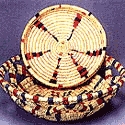
Saris/Unstitched Garments, Textiles, Weaving, Spinning, Khadi
Gadwal/ Cotton and Zari Sari Weaving of Telangana
Gadwal in Andhra Pradesh/ Telangana is known for weaving saris in cotton weft, with richly brocaded gold borders and pallus with elaborate designs. These saris were originally woven for the royalty and the nobility. The borders and body of the sari are traditionally in dramatic colours.
According to Lynton, ‘it is believed that the brocading ability of many of the weavers in the Gadwal originate from Banras, where a local maharaja sent their ancestors to learn brocade-weaving skills’. However, the designs ‘do not show any Banaras influence’ but are instead ‘strongly south-east Indian in structure and aesthetic quality’ (Lynton: p. 104).
The Gadwal saris show links with the Konrad saris of south India.
The Konrad
|
Gadwals are traditionally woven in the interlocked-weft technique (kupadam/tippadamu).
The field is usually often of unbleached cotton. Some coloured cotton or silk checks can be found in the field. However, a completely silk version, usually in bold contrasting colours is also made.
The silk borders used either tasar silk or mulberry silk. The Gadwals have the kumbham (triangular motif in sari borders; also auspicious) in the borders and are thus also known as kumbham or kupadam saris.
The end-piece of the Gadwal sari is distinct. They usually carry an inverse temple motif known as reku in the end-piece.
Gallery
YOUR VIEWS
PRACTITIONERS: INDIA
Access 70,000+ practitioners in 2500+ crafts across India.
BIBLIOGRAPHY
10,000+ listings on arts, crafts, design, heritage, culture etc.
GLOSSARY
Rich and often unfamiliar vocabulary of crafts and textiles.
SHOP at India InCH
Needs to be written.





